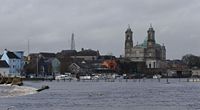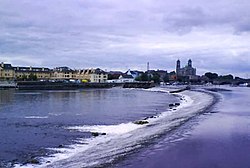Athlone
| Athlone Irish: Baile Átha Luain | |
| Westmeath | |
|---|---|
| File:St Peters Paul Athlone.jpg | |
| Location | |
| Grid reference: | N033420 |
| Data | |
| Population: | 6,958 (2006) |
| Dialling code: | 090 |
| Local Government | |
| Dáil constituency: |
Longford–Westmeath |
| Website: | www.athlone.ie |
Athlone is a town that lies on the River Shannon near the southern extremity of Lough Ree, on the border of Westmeath and County Roscommon.
The town is located close to the geographical centre of Ireland and spreads into the counties, Roscommon and Westmeath, which are located in the provinces of Connacht and Leinster respectively. The River Shannon, which runs through the town, forms the border of the counties and of the provinces. The heart of the town and its greater part lies in Westmeath.
The town has also been described as "the commercial capital of the Irish Midlands".[1]
The name "Athlone" derives from the Irish Baile Átha Luain, meaning "town of Luan's ford".[2]
History
At the heart of Athlone, both geographically and historically, is the castle. The ford of Athlone was strategically important, as south of Athlone the Shannon is impassable until Clonmacnoise (where the Esker Riada meets the Shannon), and north is Lough Ree. In 1001 Brian Bóru led his army from Kincora into the town, his fleet sailing up the river via Lough Derg to attend a gathering.

A bridge was built across the river in the 12th century, approximately 100 yards south of the current bridge. To protect this, a fort was constructed on the west bank in the town by Turloch Mór Ó Conor. On a number of occasions both the fort and bridge were subject to attacks, and towards the end of the 12th century the Anglo-Normans constructed a motte-and-bailey fortification here, which was superseded by a stone structure built in 1210 by Justiciar John Gray. The 12-sided donjon dates from this time. The rest of the castle was largely destroyed during the Siege of Athlone and subsequently rebuilt and enlarged.
During the wars that racked Ireland in the seventeenth century, Athlone held a vital position, holding the main bridge over the River Shannon into Connacht. In the Irish Confederate Wars (1641–1653), the town was held by Irish Confederate troops until it was taken late in 1650 by Charles Coote, who attacked the town from the west, having crossed into Connacht at Sligo.
Forty years later, during the pan-European War of the Grand Alliance, the city was again of key strategic importance, being one of the Jacobite strongholds defending the river-crossings into the confederate-held province of Connaught following their being routed at the Battle of the Boyne on 1 July 1690. In that year, the Jacobite forces of Colonel Richard Grace repelled an attack by 10,000 men lead by Commander Douglas. In the following year's campaign, the Siege of Athlone saw a further assault by a larger allied force in which the forces of King William and Queen Mary eventually overran the entire city, forcing the defenders to flee further west toward the River Suck at such speed that eyewitnesses account they "flung their cannons into the morass" as they fled. The most recent account of the Siege of Athlone was discovered in 2004 in an archive in the Netherlands and written on 5 July 1691 after the attack had ended. The contemporary source was penned by the victorious commanding-officer from the Netherlands, general lieutenant Godard van Reede, in letters written to his family-members on mainland Europe.[3] In the account, the commanding allied officer reported half of the city's defenders had retreated westward towards the rest of their army, leaving almost 2000 dead within the city walls with over a hundred taken prisoner among whom were dozens of officers.
It was proposed in the Republican Éire Nua programme to make Athlone the capital city of a federal United Ireland.
Music, theatre and culture
Athlone has three theatres, The Dean Crowe Theatre and Arts Centre ,The Little Theatre, and Passionfruit Theatre Company[4] The RTÉ All-Ireland Drama Festival takes place annually in Athlone, and brings together 9 amateur drama groups from across Ireland. The festival is supported by an active fringe which involves street theatre, art exhibitions, workshops and events for young people.
Athlone Literary Festival is an annual event which began in 1999 as a week-end celebration of the life and works of John Broderick (1924–1989)but which now features a great variety of speakers and debaters
Count John McCormack was born in Athlone and for many years an annual festival celebrated this world-renowned tenor.
The Athlone School of Music opened in October 2005, and is a grant aided project aimed at developing music education and services in the Midlands region.
Tourism and amenities
The River Shannon runs through Athlone and the town is a popular spot for people passing through on pleasure craft, many of whom stop off at the Marinas. Lough Ree, the largest lake on the Shannon, is a short distance upstream from Athlone to the North of the town, and is popular among anglers, birdwatchers, and swimmers. The lake shore is easily accessed from Coosan Point, and Hodson Bay. The town is also home to Lough Ree Yacht Club. The promenade is also a popular spot for anglers.
Athlone is the main retail centre in the Irish Midlands, attracting shoppers from a wide radius. It has several out-of-town shops including the largest shopping and leisure centre in Ireland outside Dublin. Athlone also has a vibrant town centre extending from Church Street to Sean Costello Street.
Sean's Bar, located on the west bank of the river, is listed by the Guinness Book of World Records as the oldest pub in Europe.[5]
Other popular attractions for visitors are the Glendeer Open Farm and the "Viking Cruise of the Shannon". The town's tourist office is located at Athlone Castle, in the town centre.

References
- ↑ "Location Profile - Athlone". IDA Ireland. http://www.idaireland.com/home/index.aspx?id=226. Retrieved 2008=09-30.
- ↑ P W Joyce, [1]. Local historians describe it as The Ford of the Moon
- ↑ 5 Jul 1691, From the Army Camp at Athloon sic: letter from Godard van Reede, general lieutenant of their majesties of England combined forces at land and at sea in Ireland 1690-1691, to his father, a multimedia webcast of a live broadcast by Ballinasloe Community Radio 102.8 FM, Jul 10, 2004
- ↑ http://www.passionfruittheatre.com
- ↑ http://www.irelandlogue.com/best-of/seans-bar-athlone-oldest-pub-in-ireland.html
Outside links
- Athlone.ie - Official Town Portal
- EuroFestival.ie - Euro-Festival Athlone 2010